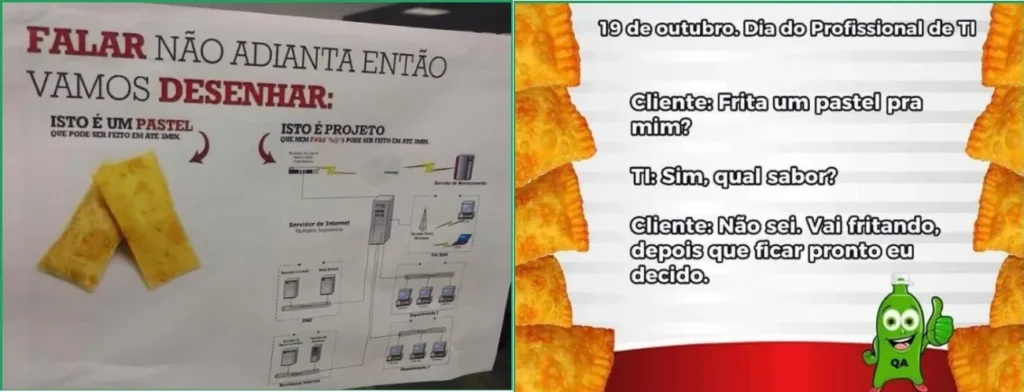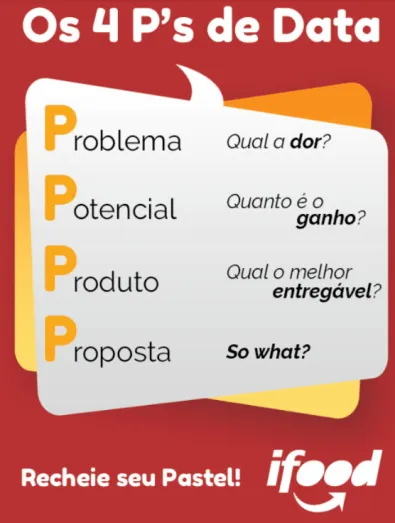Lucas Pedote
💻 Data & Analytics on iFood
“Can I have a pastry?”
Every good Tech professional gets goosebumps when they hear the word Fried pastry. And most of the time it wasn't due to food poisoning!
This culinary delicacy has become jargon in the industry and represents short task requests, “small” adjustments (in the customer's view) that emerge across sprints.
These requests, like a good pastry, need to be freshly fried, otherwise it is no longer useful.

The biggest problem this practice brings is the lack of prioritization It is logical cadence of tasks. As said by the investor Shawn Carolan: “Startups don't starve, they drown” (Startups don't starve, they drown). The work to be done always exists—and always in abundance. By not knowing how to prioritize it, we end up drowning in demands, without adding value to the business and, as a result, the company dies.
Date flavor pastry
Bringing it to the reality of the Data Analysis team at iFood, our classic pastry order is “Can you do a dash?”. In which basically the internal customer wants to have visibility of information or analyze a topic that came to mind.
And far be it from me to say that distributing information to business is a bad thing, quite the opposite! It’s part of our area’s mission. However, just like creating and changing features in products, information and visualizations to be made are infinite and will not necessarily add value to the business.
This number of short requests, without context and, sometimes, “backlogged”,* is a latent pain in the Data teams of several companies and demotivates professionals because they do not know what/why they are doing something.
*Someone in a higher position asks you something urgently and you simply do what they say.
Enough with the wind pastels!
Seeking to ensure better prioritization, we identified that what our company lacks are not task management and monitoring tools, but rather a change of mindset! Every analysis required has an intrinsic value that needs to be revealed!
So, our proposal is to transform this type of dialogue:
“Can you do a dash?” → “Okay…”
in “Can you dash?” → “Oops! let's go. What are the 4Ps?”
And what the heck are these Ps?? Let's go to them!

Problem
- Every demand request needs to start here! Explaining what is the pain that seeks to be resolved;
- Who does it impact? When does it happen? What is the context business involved?
- This already brings the Data Analyst to the table to think together. He/she gains knowledge and a reason to do something.
Potential
- Once this problem is understood, it is time to measure what is the potential to resolve it;
- It is at this moment that we avoid drowning by directing our strokes to the side with the greatest potential to take us to our final destination;
- Just because a problem is understood does not mean it needs to be resolved. now;
- The ability to prioritize by impact and not because decibels of the requester¹ or by mutual affection index² It is absolutely transformative.
¹ Who shouts the loudest
² Who is my best friend?
Product
- Once you understand the problem and are clear that there is potential, it is time to ask: what is the best deliverable?
- What was requested as a deliverable (a dash, in this case) is not necessarily the correct product to solve that pain;
- In the Data scenario, a product can be a simple response (grew/decreased), a table via query or a new measurement methodology, among others;
- It is imperative to be clear and discuss this before of “getting fried”;
- This boosts our efficiency and avoids rework.
Proposal
- This last P we put as the Data Analyst cherry on the cake;
- If we want our work to be much more than just “doing dashes”, is in our hand add value and intelligence to what we deliver!
- Therefore, what we demand at iFood is that every Data Product comes out with a layer of intelligence, a action proposal to be taken from this;
- In this way, we force ourselves to guarantee that the product generated effectively has value for the business;
- A dash in which no action is taken is doomed to go to drawer
Puts, another form…?
No! =D
The main objective of the methodology is not to be a bureaucratic blocker to be filled in the JIRAs of life. We want a communication aligner to ensure we are speaking the same language (Data, Tech, Business, everyone), swimming in the same direction and tackling the problems that make sense.
When someone says:
“Oops, come on. What are the 4Ps?”, the other party needs to understand “Oops, come on. Gives me context and relevance?”
And both build from that!
When demand stops being crossed, meaningless and flavorless, it becomes filling! And a stuffed, creamy and well-made pastry makes your mouth water, no more goosebumps!
It's closed! It's ready?
Creating a common language and changing a culture are long-term jobs that involve creativity, perseverance and presence! This methodology, which came to life in May 2019, has already yielded many fruits, but it is still a path under construction!
It fills me with pride and warms my heart to hear, in a performance evaluation committee, the phrase “So-and-so still needs to absorb the 4Ps” and everyone in the room understands what does that mean!
We are developing professionals capable of dialoguing with their customers, understanding the business they are involved in, adding value to their deliveries and (very important too) don't drown! haha
Every day it becomes clearer how the iFood Data team is taking on a leading role in our company and leaving behind the days of “dashe makers”.
And I hope this article helps you, your area and your company move towards the change in mentality that leads us to grow and surf the best waves!
#FillYourPastel


